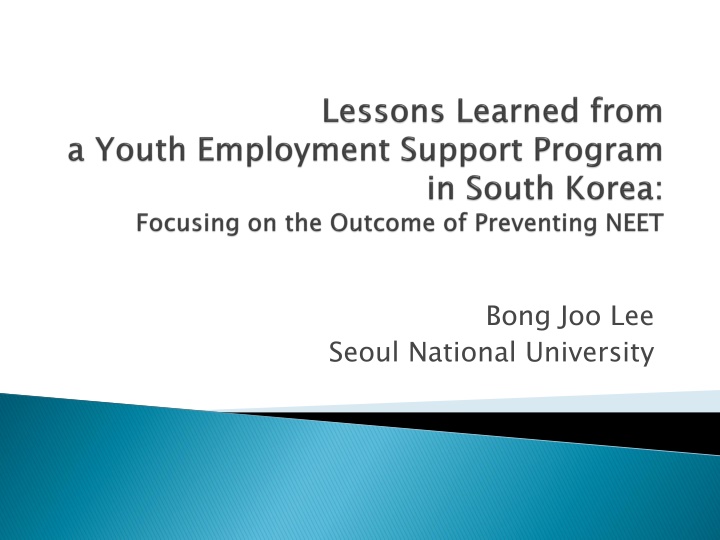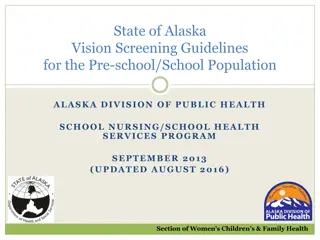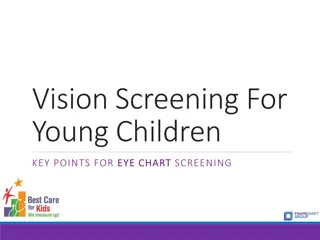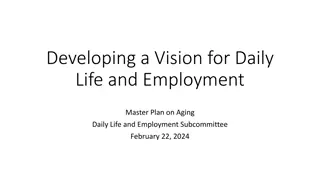
Youth Unemployment and NEET Prevention Program in South Korea
Explore the challenges of youth unemployment in South Korea, focusing on the NEET (Not in Employment, Education, or Training) issue, its impact on human capital, and the comprehensive program developed to address it by the Community Chest of Korea. Learn about the initiatives, support, and strategies aimed at preventing NEET among disadvantaged youth aged 14-24 through education, job training, family support, and community engagement.
Download Presentation

Please find below an Image/Link to download the presentation.
The content on the website is provided AS IS for your information and personal use only. It may not be sold, licensed, or shared on other websites without obtaining consent from the author. If you encounter any issues during the download, it is possible that the publisher has removed the file from their server.
You are allowed to download the files provided on this website for personal or commercial use, subject to the condition that they are used lawfully. All files are the property of their respective owners.
The content on the website is provided AS IS for your information and personal use only. It may not be sold, licensed, or shared on other websites without obtaining consent from the author.
E N D
Presentation Transcript
Bong Joo Lee Seoul National University
Population (2016): about 51 million Per capita GDP (2016): $27,633 HDI (2014): 0.98 (very high, 17th) Gini (2013): 30.2 (medium) Area: 100,210 km2
Youth Unemployment has become a major social policy issue Eurofound (2012): youth unemployment rate - 15.7% (2007) 22.4% (2012) South Korea is no exception Youth (aged 15-29) unemployment rate increased from 8% in 2000 to 10.5% in 2018. NEET (Not in Employment, Education, or Training) A key indicator to monitor the status of youth in labor market NEET at 18.9% in 2016 (OECD avg. 14.4%)
OECD definition Aged between 15 and 29 Unemployment: less than 1 hour of paid labor for the past week Having received no education or training for the past four weeks In this presentation NEET: using no regular education institution, or school or institution for advanced education or employment, not working, and not in a situation inevitably preventing employment due to military service or health problems
Delay and decrease of human capital in the short term Scarring effect decrease the future employment and life-time earnings NEET long-term poverty Social cost of NEET (Eurofound, 2012) The social cost of youth NEET among 26 countries in the European Union (EU) in 2011 was approximately 153 billion euro 1.2% of the total GDP of the EU
Developed by the Community Chest of Korea (United Way of Korea) A comprehensive NEET prevention and employment support program In order to solve limitations of previous programs focusing only on job placements 14-19 years old: prevention of NEET 20-24 years old: employment support programs Implemented as a demonstration program in 11 communities for 3 years (2016-18) Support of $1.3 million USD for 3 years per a center Targeting about 100 disadvantaged youths in each center in a year
14-24 olds youths Education support, job training, consulting, coaching Comprehensive Program -- 3 steps Family Family function support, economic (activities) support Community Neighborhood activists training, networking with people and resources Wraparound integrated case management Economic and job activity support, monitoring, home visits, counseling, service referrals
Cycle: 1 year Participants Recruitment Participants Recruitment Intake Counseling Intake Counseling Establish Self- -growrh Plan Establish growrh Plan Service provision and Participation Service provision and Participation Monitoing and Evaluation Monitoing and Evaluation Assessment Assessment Consent Consent Termination Termination Self Recruitment PR Making Referral Outreach Recruitment PR Making Referral Outreach Information gathering about participant and family Information gathering about participant and family Evaluate change priorities Participant need assessment Evaluate change priorities Participant need assessment Draw up letter of agreement (with rights and duty of the particiation) Draw up letter of agreement (with rights and duty of the particiation) By service goals (monthly plan) By service goals (monthly plan) Activities by self plan Activities by self- -growth plan Self by self plan Outcome evaluation by participants' changes Self- -monitoring by self- -growth plan Outcome evaluation by participants' changes monitoring growth Case close by servvice evaluation needs are met) Drop out ( moving, military enlistment, out of contact) Case close by servvice evaluation (when needs are met) Drop out (due to moving, military enlistment, out of contact) growth (when due to
A total of 1,780 youth participated 15-19: 914 20-24: 866 Recruitment Using local community children s centers, social work offices in schools, and youth counseling and welfare centers An average of 4-5 workers in a center Average participation duration: 21.5 months
Program participation (per person) average 3.5 Program participation (per person) Programs Programs Contents Contents 3 3 Domains Domains Min. 0 Max. 71 Academic, Art, Musiic, Physical, and Vocational educ ation programs Job-related support, Internship & Practical training, and Start-up support Education 0.3 0 22 Financial Support 1.9 0 105 Individual Individual Humanities, Academic coaching, Career coaching, Psychological-emotional supports Coaching 3.4 0 30 Vision Program Vision Camp, VIsion Consulting, Youth Forum 31.8 1.6 0 0 245 29 Case management Case management, counselling Family Support Increasing family functioning 1.8 0 43 Parent education, Family thrapy, Self-support meeting, Psychological-emotional support Family Coaching Family Family 1.3 0 52 Vocational education, Job-related support, Start-up support, Financial support Financial Support (family) 367.3 (per center) 95 659 Resource Networking Client referral, Service link, and linking to resources 39.2 20 79 Establishing networks among the community agencies Agency Networking (per center) Community Community 503.5 (per center) 91 1,027 Outreach, Network meeting,, Community event, Visi on program event, Site-visit & monitioring, on-line PR, off-line PR, etc Community Empowetment 1,727.3 (per center) 145 7,516 Community Action Organizing, Meeting, Education, Action
Implementation evaluation Site visits Observations In-depth interviews with workers, participants, parents, and community residents Outcome evaluation (focusing on 20-24 years old in this presentation) Longitudinal quasi-experimental design 3 years (2016-18): 3 annual surveys 11 demonstration sites and 6 comparison sites The outcome evaluation focused on comparison between participants and non-participants in the demonstration sites Time 3 Time 3 December, 2018) Treatme nt 423 (15.6) (100.0) Time 1 August, 2016) Time 1 Time 2 October, 2017.) Time 2 (October- -December, 2018) Comparis on 2,293 (84.4) (October (June- -August, 2016) (June (August (August- -October, 2017.) Comparison Treatme Compariso n 2,224 (85.4) Treatme nt 380 (14.6) Total Total Total nt 193 (9.7) N N (%) 1,797 (90.3) 1,990 (100.0) 2,604 (100.0) 2,716 (%)
Difference-In-Difference Estimation To control for (unobserved) differences between demonstration and comparison sites Program Effect It measures the difference in the change of outcome variable between treatment and comparison groups over time
Variable Variable Operational Definition Operational Definition having job-seeking intention (=1) / not having job-seeking intention (ref.=0) currently NEET (=1) / not NEET (ref.=0) * NEET: currently not in school, not in education or training, and unemployed Job-seeking intention Outcome Variables Outcome Variables NEET Independent Variables Independent Variables Program Participation Participated (=1) / Not participated (ref.=0) Gender Age Female (ref.=0) / Male (=1) in years Under middle-school graduate (ref.=0) / under high-school graduate / Above in-college Education(dummy) National Basic Living security beneficiary(dummy) non-receiving (ref.=0) / Receiving Control Variables Control Variables Family Type (dummy) with both parents(ref.=0) / with single parent / with grandparents / etc. Subjective Economic Condition (dummy) low(ref.=0) / moderate / high / not answered Father s employment unemployed (ref.=0) / employed (=1) under high-school graduate(ref.=0) / high-school graduate / Above in-college Father s education (dummy)
Model 1 Model 1 Model 2 Model 2 Model 3 Model 3 DV: Job Search Intention DV: Job Search Intention (T1 vs. T2) (T2 vs. T3) (T1 vs. T3) B (se) B (se) B (se) Group Group Treatment group -0.02 (0.035) 0.022 (0.024) -0.038 (0.036) T2(ref. T1) 0.040** (0.014) time time T3(ref. T2) -0.029* (0.012) T3(ref. T1) 0.003 (0.015) TG T2(ref. T1) 0.038 (0.039) Group Group time time TG T3(ref. T2) 0.032 (0.028) TG T3(ref. T1) 0.083* (0.039) *While controlling for the other variables
Model 1 Model 1 Model 2 Model 2 Model 3 Model 3 DV: Probability of NEET DV: Probability of NEET (T1 vs. T2) (T2 vs. T3) (T1 vs. T3) B (se) B (se) B (se) Group Group Treatment group 0.03 (0.027) 0.051** (0.019) 0.058* (0.027) T2(ref. T1) -0.005 (0.008) time time T3(ref. T2) 0.021** (0.008) T3(ref. T1) 0.021* (0.009) TG T2(ref. T1) 0.003 (0.031) Group Group time time TG T3(ref. T2) -0.058* (0.023) TG T3(ref. T1) -0.067* (0.030) *While controlling for the other variables
DV=Job search intention DV=Job search intention probability of NEET probability of NEET Model 1 (T1 vs.T2) Model 2 (T2 vs. T3) Model 3 (T1 vs .T3) Model 1 (T1 vs.T2) Model 2 (T2 vs. T3) Model 3 (T1 vs .T3) B(se) B(se) B(se) B(se) B(se) B(se) 0.041+ (0.022) 0.079* (0.040) -0.007 (0.012) -0.005 (0.031) Comp2 T2 Treat T2 -0.071*** (0.019) -0.041 (0.029) 0.007 (0.012) -0.050* (0.024) Comp2 T3 Group Time Group Time Treat T3 -0.037+ (0.022) 0.042 (0.040) 0.005 (0.013) -0.060* (0.030) Comp2 T3 Treat T3
Outcome evaluation The program participants intention to find a job increased by 8.3% compared to non-participants during the three-year program period NEET decreased by 5.8% in the 2nd year NEET decreased by 6.7% in the 3rd year Implementation evaluation: success factors Social workers efforts to establish rapport with the disadvantaged youth in the community: needs assessment, home visiting, counselling, and actively encouraging the participation of the youth Use of individualized service plan (self-growth plan) Adapting to the youth s various needs and situations: flexibility Empowerment approach: to reduce stigma
Importance of choice and concentration To have a long-term view Building local capacity is important Securing stability and capacity of workers To give a pre planning phase To provide supports to preparation period and capacity building Importance of ongoing monitoring system Collective impact approach is needed importance of networking Funding scheme: growth-led staged support system? To maintain adequate worker employment costs To employ action research approach






















